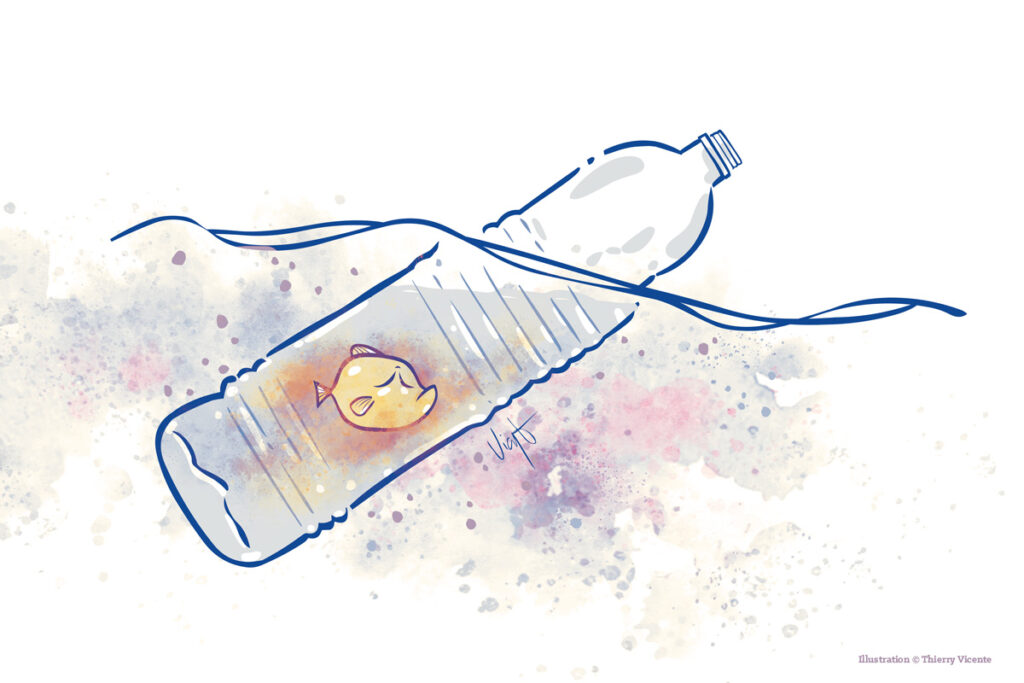[LUM#18] Plastic is dramatic
Overfishing, global warming, water acidification... Times are hard for fish, with fewer and fewer of them plying the oceans. These threats are compounded by another: plastic. Researchers have explored the effects of exposure to microplastics, and have shown that the impact of these tiny particles on marine fauna is inversely proportional to their size...

"When we think of plastic pollution, we often see images of turtles or fish smothered by large debris, but there's another problem with plastics: they break down into sometimes barely visible particles, micro- and nanoplastics, which can have effects on fish metabolism, partly due to the fact that they carry additives and pollutants," explain Marie-Laure Bégout and Xavier Cousin, researchers at the Marbec* laboratory. A cocktail of various substances, including perfluorooctane sulfuric acid, used as a flame retardant in plastics, benzophenone-3, which acts as a UV filter in sun creams, and benzo(a)pyrene, contained in petroleum derivatives. " All these pollutants can be found from the surface to the bottom of the water, because they are present in plastics that float, such as polyethylene, but also in more
dense plastics that sink to the bottom of the water, such as PVC," explains Xavier Cousin.
To gain a better understanding of the consequences of these substances, the researchers exposed a fish, the marine medaka, to plastic particles coated or uncoated with these three pollutants. " We were thus able to study their effects at concentrations similar to those found in their environment throughout the animal's life cycle", emphasizes Xavier Cousin.
Growth reduction
The first finding was a 20-35% reduction in fish growth. " These effects are much greater after 4 months' exposure than after 2 months, which underlines the importance of long-term studies to assess the toxicity of microplastics," explains Xavier Cousin. Growth reduction was more marked in females, "probably due to their higher energy requirements than males during reproduction", adds Marie-Laure Bégout.
Reproduction, in fact, seems to be the main target of these disruptors. Researchers have found that exposed females lay fewer eggs, a phenomenon that can lead to a drop of up to 50% in the usual reproductive rate. " In marine medaka, exposure to almost all microplastics induces a delay in the onset of egg-laying and a reduction in the number of eggs produced per female per day", the researchers add. They also found that the effects varied according to the type of plastic and pollutant, and could even affect the larvae of the next generation. " When fish are exposed to a PVC-type plastic containing benzophenone-3, behavioral problems are observed in the larval offspring".
Risk assessment
If all these consequences are enough to lead to serious ecological dysfunction, the results of this study probably still underestimate reality: "In the laboratory, fish are pampered, but in their natural environment they are exposed to other pressures: predation, fishing, other pollutants. Microplastic pollution adds to these factors, all of which are likely to cause problems for the fish," laments Marie-Laure Bégout.
Every year, 8 to 10 million tonnes of plastic end up in the oceans. 10% float as micro-waste, potentially carrying pollutants of all kinds. We therefore recommend including this mode of pollutant transfer in the ecotoxicological risk assessment of microplastics," conclude the researchers. Understanding the mechanisms underlying biological disruption will also make it possible to assess the extent to which these effects can be generalized to all types of microplastics, in order, for example, to prioritize the control of
emissions."
Eternal fragments
Will that polyethylene plastic bag we just let fly out to sea eventually disappear? " It will take several hundred years for it to degrade completely, but it is rapidly fragmenting into smaller and smaller particles", answers Matthieu George. With his colleague Pascale Fabre, the Charles Coulomb Laboratory researcher** is studying the degradation processes of these polymers. " Under the combined effect of water, UV rays and the mechanical stress exerted by waves, a piece of plastic bag will take around 10 years to degrade into tiny fragments, the famous microplastics measuring less than a millimetre in size", explains Matthieu George. Unfortunately, once this size has been reached, the fragmentation process no longer works, and these plastic particles can persist for... an eternity. "They are now found absolutely everywhere in the oceans, from north to south and from bottom to surface. This invisible pollution is much worse than the visible plastic pollution, because these microplastics are not going to disappear and we can't recover them from the water", deplores the researcher. And biodegradable plastics? " It's not a miracle solution, because the ocean environment is not at all conducive to their degradation, which only takes place under very specific conditions," emphasizes Matthieu George. So what can be done to deplasticize the oceans? " The only solution is to prevent these plastics from reaching the seas and oceans by reducing their production and improving waste collection", concludes the researcher.
*Marbec (UM, IRD, CNRS, Ifremer)
**L2C (UM, CNRS)
UM podcasts are now available on your favorite platforms (Spotify, Deezer, Apple podcasts, Amazon Music...).